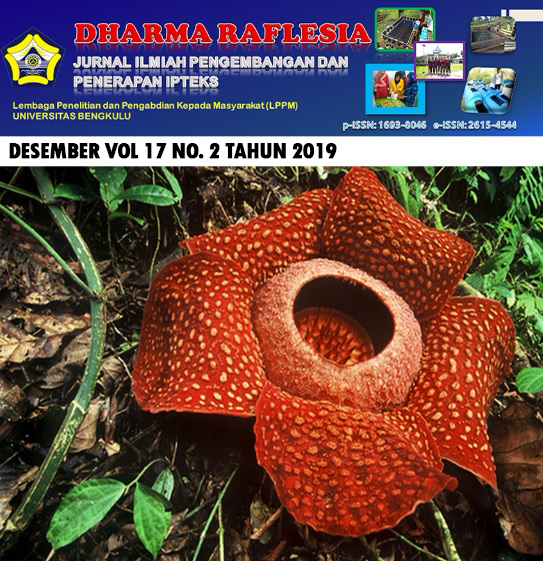Main Article Content
Abstract
The Canteen is a facility that is often visited by many people, therefore the canteen cleanliness and health need attention. Especially The canteen in places such as education providers. Whatever is served by canteen will be consumed by campus residents and become a daily habit to consume it. Contamination that occurs in the canteen will endanger campus residents, and if consumed by many people will cause many victims. This will certainly endanger the health of campus residents, especially students and employees. Food handler’s personal hygiene and completeness of APD are closely related to food contamination. For this reason, it is necessary to develop a healthy canteen, one of which is by providing education about personal hygiene and the importance of using APD when food is personalized. This activity is a community service of the Nutrition Study Program Faculty of Health Sciences (FIKes)Esa Unggul University. The purpose of this activity is to create a healthy and pollution free canteen Esa Unggul University. All food handlers canteen attended and participated in this activity well. Activities like this are important to carry out to cultivate a healthy canteen in an educational environment such as a campus.
Article Details
- Authors retain copyright and grant the journal right of first publication with the work simultaneously licensed under a Creative Commons Attribution-ShareAlike 4.0 (CC BY-SA) that allows others to share the work with an acknowledgement of the work's authorship and initial publication in this journal.
- Authors are able to enter into separate, additional contractual arrangements for the non-exclusive distribution of the journal's published version of the work (e.g., post it to an institutional repository or publish it in a book), with an acknowledgement of its initial publication in this journal.
- Authors are permitted and encouraged to post their work online (e.g., in institutional repositories or on their website) prior to and during the submission process, as it can lead to productive exchanges, as well as earlier and greater citation of published work (See The Effect of Open Access).
- This work is licensed under a Creative Commons Attribution-ShareAlike 4.0 International License.
References
- Fatmawati, S., Rosidi, A. and Handarsari, E. 2013. ‘Perilaku Higiene Pengolah Makanan Berdasarkan Olahraga Pelajar Jawa Tengah’, Pangan dan Gizi, 04(08), pp. 45–52.
- Handayani, N. M. A. et al. 2015. ‘Faktor yang Mempengaruhi Perilaku Penjamah Makanan dalam Penerapan Cara Pengolahan Pangan yang Baik pada Industri Rumah Tangga Pangan di Kabupaten Karangasem Factors Associated with the Behavior of Food Handlers in the Application of Good Manufacturing Pr’, Public Health and Preventive Medicine Archive, 3(2), pp. 194–202.
- Jenkins, K. T. et al. 2015. ‘A cross-sectional observational study of the nutritional intake of UK primary school children from deprived and non-deprived backgrounds: implications for school breakfast schemes’, International Journal of Behavioral Nutrition and Physical Activity. International Journal of Behavioral Nutrition and Physical Activity, 12(1), pp. 1–10. doi: 10.1186/s12966-015-0238-9.
- Kemenkes RI. 2003. Keputusan Kesehatan RI No. 715/Menkes/SK/V/2003.
- Kemenkes RI. 2003a. Keputusan Menteri Kesehatan Republik Indonesia Nomor 942/MENKES/SK/VII/2003 Tentang Pedoman Persyaratan Hygiene Sanitasi Makanan Jajanan. Jakarta.
- Kemenkes RI. 2011. ‘Buku Saku Petugas Kesehatan Lintas Diare’, Departemen Kesehatan RI, Direktorat Jendral Pengendalian Penyakit dan Penyehatan Lingkungan, pp. 1–40.
- Khairina, A.D., Palupi, I.R., & Prawiningdyah, Y. 2019. ‘Pengaruh Media Visual Higiene Sanitasi Makanan Terhadap Praktik Higiene Penjamah Makanan Di Kantin Kampus’, Journal of Health Education, 3(2), pp. 65–74.
- Siagian, A. 2002.Mikroba Patogen pada Makanan dan Sumber Pencemarannya. Universitas Sumatera Utara.
- Susanna, D. and Hartono, B. 2003. ‘Pemantauan Kualitas Makanan Ketoprak Dan Gado-gado Di Lingkungan Kampus UI Depok, Melalui Pemeriksaan Bakteriologis’, MAKARA journal, 7(1), pp. 21–28.
References
Fatmawati, S., Rosidi, A. and Handarsari, E. 2013. ‘Perilaku Higiene Pengolah Makanan Berdasarkan Olahraga Pelajar Jawa Tengah’, Pangan dan Gizi, 04(08), pp. 45–52.
Handayani, N. M. A. et al. 2015. ‘Faktor yang Mempengaruhi Perilaku Penjamah Makanan dalam Penerapan Cara Pengolahan Pangan yang Baik pada Industri Rumah Tangga Pangan di Kabupaten Karangasem Factors Associated with the Behavior of Food Handlers in the Application of Good Manufacturing Pr’, Public Health and Preventive Medicine Archive, 3(2), pp. 194–202.
Jenkins, K. T. et al. 2015. ‘A cross-sectional observational study of the nutritional intake of UK primary school children from deprived and non-deprived backgrounds: implications for school breakfast schemes’, International Journal of Behavioral Nutrition and Physical Activity. International Journal of Behavioral Nutrition and Physical Activity, 12(1), pp. 1–10. doi: 10.1186/s12966-015-0238-9.
Kemenkes RI. 2003. Keputusan Kesehatan RI No. 715/Menkes/SK/V/2003.
Kemenkes RI. 2003a. Keputusan Menteri Kesehatan Republik Indonesia Nomor 942/MENKES/SK/VII/2003 Tentang Pedoman Persyaratan Hygiene Sanitasi Makanan Jajanan. Jakarta.
Kemenkes RI. 2011. ‘Buku Saku Petugas Kesehatan Lintas Diare’, Departemen Kesehatan RI, Direktorat Jendral Pengendalian Penyakit dan Penyehatan Lingkungan, pp. 1–40.
Khairina, A.D., Palupi, I.R., & Prawiningdyah, Y. 2019. ‘Pengaruh Media Visual Higiene Sanitasi Makanan Terhadap Praktik Higiene Penjamah Makanan Di Kantin Kampus’, Journal of Health Education, 3(2), pp. 65–74.
Siagian, A. 2002.Mikroba Patogen pada Makanan dan Sumber Pencemarannya. Universitas Sumatera Utara.
Susanna, D. and Hartono, B. 2003. ‘Pemantauan Kualitas Makanan Ketoprak Dan Gado-gado Di Lingkungan Kampus UI Depok, Melalui Pemeriksaan Bakteriologis’, MAKARA journal, 7(1), pp. 21–28.
